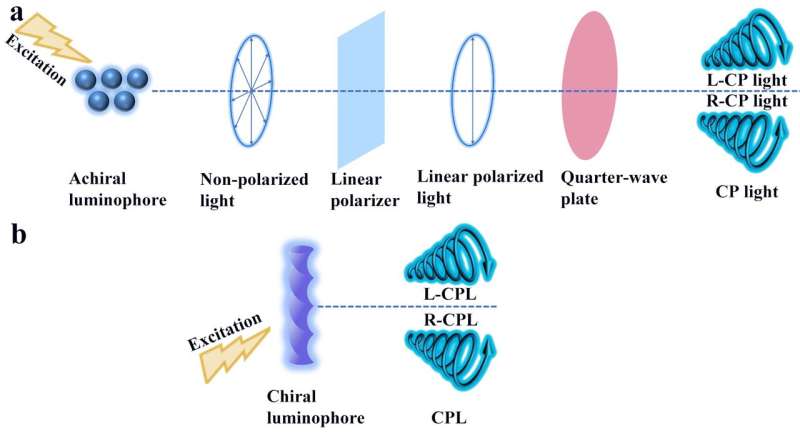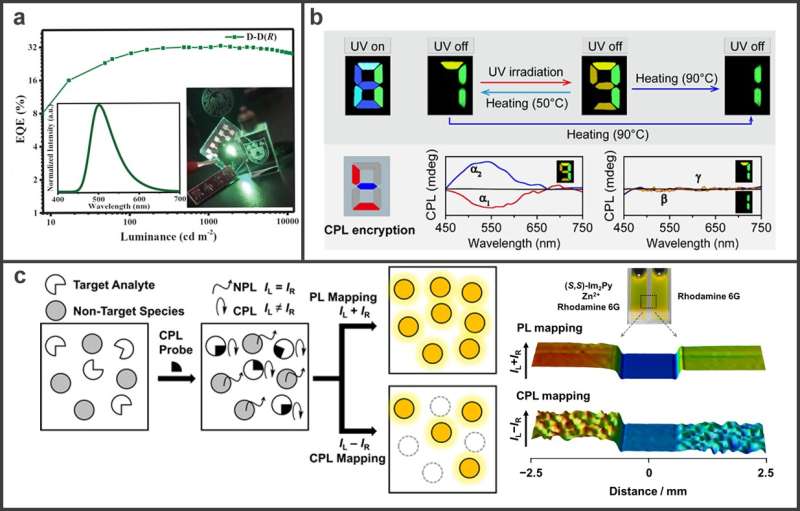Circularly polarized luminescence from organic micro-/nano-structures

Circularly polarized light exhibits promising applications in future displays and photonic technologies. Traditionally, circularly polarized light is converted from unpolarized light by the linear polarizer and the quarter-wave plate. During this indirectly physical process, at least 50% of energy will be lost. Circularly polarized luminescence (CPL) from chiral luminophores provides an ideal approach to directly generate circularly polarized light, in which the energy loss induced by a polarized filter can be reduced. Among various chiral luminophores, organic micro-/nano-structures have attracted increasing attention owing to the high quantum efficiency and luminescence dissymmetry factor (glum).
In a new paper published in Light: Science & Applications, Chinese scientists from Nanjing University of Posts and Telecommunications (NUPT) have summarized the latest progress of CPL-active organic micro-/nano-structures.
This review expounded the design principles of CPL-active organic micro-/nano-structures from the aspect of the construction of micro-/nano-structure and the introduction of chirality, and some typical organic micro-/nano-structures with CPL activity were introduced in detail, including self-assembly of small molecules and π-conjugated polymers, and self-assembly on micro-/nanoscale architectures.
The formation of organic micro-/nano-structures is driven by intermolecular non-covalent interactions, which is dynamic and sensitive to external stimuli. In this review, they discussed the external stimuli that can regulate CPL performance, including solvents, pH value, metal ions, mechanical force, and temperature.

The potential applications were also discussed:
1. In a conventional organic light-emitting diode (OLED), it is usually necessary to use a circular polarizer to reduce the reflectivity of the surrounding environment. Thus, only half of the emitted light can reach the eyes, causing great loss of brightness and energy efficiency. The OLED based on CPL-active materials can directly emit circularly polarized light with the same handedness as the circular polarizer, reducing the energy loss.
2. In the fields of optical information recording and encryption, materials with CPL activity can achieve higher storage density and security through both optical signals and chiral signals.
3. Compared with other optical sensing technologies, sensing based on CPL-active materials can eliminate the interference of background fluorescence and unpolarized light, providing higher sensitivity and resolution.
Furthermore, asymmetric quantum efficiency (φa), a new indicator, was proposed to evaluate the comprehensive performance of CPL-active materials, which was defined as the ratio of left- or right-CPL light intensity to incident light intensity. The φa can intuitively reflect the degree of energy loss, and the larger φa represents the lower energy loss.
This review provides an understanding of the relationship among molecular designs, assembly structures, and chiroptical properties, and will provide a guide for the design of excellent CPL-active materials. It is hoped that this review will encourage more researchers to explore this emerging and rapidly developing research area.
More information: Yongjing Deng et al, Circularly polarized luminescence from organic micro-/nano-structures, Light: Science & Applications (2021). DOI: 10.1038/s41377-021-00516-7
Journal information: Light: Science & Applications
Provided by Chinese Academy of Sciences



















